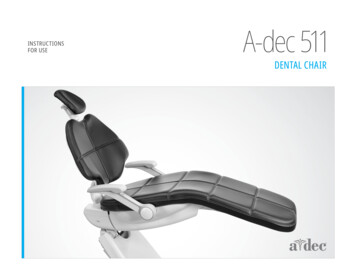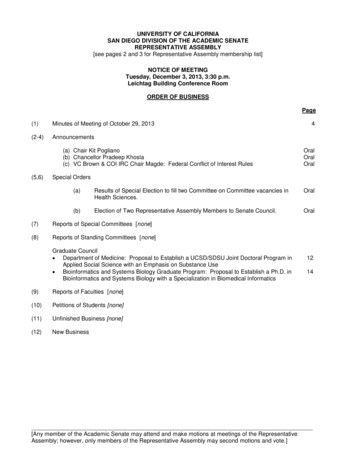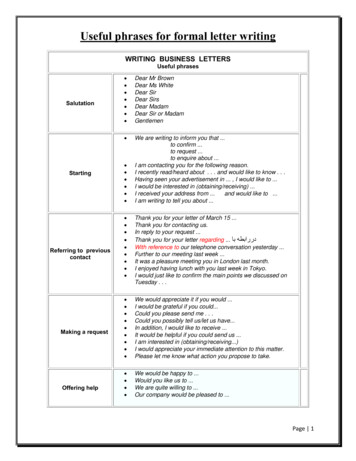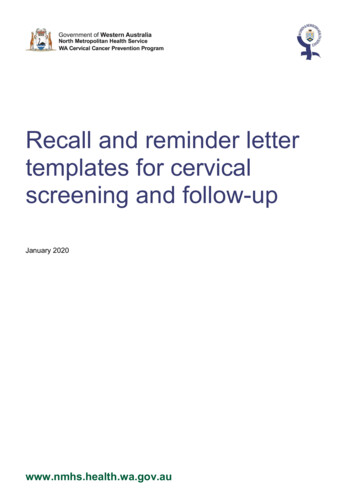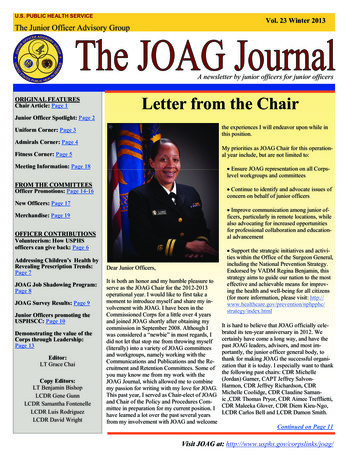
Transcription
U.S. PUBLIC HEALTH SERVICEVol. 23 Winter 2013The Junior Officer Advisory GroupA newsletter by junior officers for junior officersORIGINAL FEATURESChair Article: Page 1Letter from the ChairJunior Officer Spotlight: Page 2the experiences I will endeavor upon while inthis position.Uniform Corner: Page 3Admirals Corner: Page 4My priorities as JOAG Chair for this operational year include, but are not limited to:Fitness Corner: Page 5Meeting Information: Page 18 Ensure JOAG representation on all Corpslevel workgroups and committeesFROM THE COMMITTEESOfficer Promotions: Page 14-16New Officers: Page 17EVP winners from the University of IllinoisChicagoMerchandise: Page 19OFFICER CONTRIBUTIONSVolunteerism: How USPHSofficers can give back: Page 6Addressing Children’s Health byRevealing Prescription Trends:Page 7JOAG Job Shadowing Program:Page 8JOAG Survey Results: Page 9Junior Officers promoting theUSPHSCC: Page 10Demonstrating the value of theCorps through Leadership:Page 13Editor:LT Grace ChaiCopy Editors:LT Benjamin BishopLCDR Gene GunnLCDR Samantha FontenelleLCDR Luis RodriguezLCDR David WrightDear Junior Officers,It is both an honor and my humble pleasure toserve as the JOAG Chair for the 2012-2013operational year. I would like to first take amoment to introduce myself and share my involvement with JOAG. I have been in theCommissioned Corps for a little over 4 yearsand joined JOAG shortly after obtaining mycommission in September 2008. Although Iwas considered a “newbie” in most regards, Idid not let that stop me from throwing myself(literally) into a variety of JOAG committeesand workgroups, namely working with theCommunications and Publications and the Recruitment and Retention Committees. Some ofyou may know me from my work with theJOAG Journal, which allowed me to combinemy passion for writing with my love for JOAG.This past year, I served as Chair-elect of JOAGand Chair of the Policy and Procedures Committee in preparation for my current position. Ihave learned a lot over the past several yearsfrom my involvement with JOAG and welcome Continue to identify and advocate issues ofconcern on behalf of junior officers Improve communication among junior officers, particularly in remote locations, whilealso advocating for increased opportunitiesfor professional collaboration and educational advancement Support the strategic initiatives and activities within the Office of the Surgeon General,including the National Prevention Strategy.Endorsed by VADM Regina Benjamin, thisstrategy aims to guide our nation to the mosteffective and achievable means for improving the health and well-being for all citizens(for more information, please visit: egy/index.htmlIt is hard to believe that JOAG officially celebrated its ten-year anniversary in 2012. Wecertainly have come a long way, and have thepast JOAG leaders, advisors, and most importantly, the junior officer general body, tothank for making JOAG the successful organization that it is today. I especially want to thankthe following past chairs: CDR Michelle(Jordan) Garner, CAPT Jeffrey SalvonHarmon, CDR Jeffrey Richardson, CDRMichelle Coolidge, CDR Claudine Samanic ,CDR Thomas Pryor, CDR Aimee Trefflietti,CDR Maleeka Glover, CDR Diem Kieu-Ngo,LCDR Carlos Bell and LCDR Damon Smith.Continued on Page 11Visit JOAG at: http://www.usphs.gov/corpslinks/joag/
Page 2The JOAG JournalJunior Officer SpotlightContributed by LT Amy LuoOfficer: Amy KolwaiteRank: LCDRCategory: NurseEducation: Master of Public Health (MPH), University ofArizona; Master of Science (MS), Arizona State University;Bachelor of Science in Nursing (BSN), Auburn UniversityHometown: Atlanta, GeorgiaAgency: Centers for Disease Control and Prevention (CDC)Current Assignment and Duties: I am currently a CDC Preventive Medicine Fellow assigned to the Division of ViralHepatitis focusing on global hepatitis. The CDC PreventiveMedicine Fellowship program provides hands-on experiencein public health agencies at the federal, state, and local levelsin designing and evaluating programs, developing health policy, conducting community health improvement projects,managing public health projects and developing and applyingleadership skills. My current projects include collaboratingwith other countries to address the burden of hepatitis in theircountries, developing guidelines on implementation of hepatitis B birth dose into an immunization program, and lookingfor new and innovative ways to deliver hepatitis B vaccine torural and hard to reach areas.Previous Assignment(s): CDC Epidemic Intelligence Service (EIS) Officer assigned to the Kentucky Department forPublic Health. Prior to EIS, I worked as a Pediatric NursePractitioner in emergency departments in Atlanta and Phoenix.How did you find out about the PHS? I learned about thePHS when I was accepted into the EIS program. My EIS supervisors were PHS officers and they shared information ontheir experiences and reasons for joining the PHS. Their stories solidified my decision to join the PHS.What are your goals with the PHS? My goal is to combinemy background in nursing with the public health leadershipskills I have gained through my PHS assignments into a career that addresses critical public health concerns. I plan tostay in PHS throughout my career.What is your most memorable PHS experience so far?During my time as an EIS officer, I spent three months inLCDR Amy KolwaiteUganda working on a Stop Transmission of Polio (STOP)team, assisting country-level efforts in the global effort toeradicate polio. Another memorable experience was workingwith two deployment teams conducting field exercises inKentucky. As a junior officer, it was a privilege to workalongside so many PHS officers from diverse categories andagencies and to learn from their experiences.What advice would you give to prospective PHS applicants (or other Jr. Officers)? Find mentors in your categorywho are dedicated to sharing their experiences, providingguidance, and helping you succeed. Also, don’t be afraid tovolunteer for PHS activities. Volunteering for different committees and projects is a great way to get to know PHS officers throughout the different agencies.How has PHS changed your career as a nurse? When Ifinished nursing school, I pictured myself always working inthe hospital providing clinical care. Through the PHS, I havelearned that there are so many opportunities available fornurses outside the traditional hospital setting. The training Ihave received and experiences I have gained as a PHS officerhave made me look forward to using my public health nursing skills on a more global level.If you are interested in appearing in the next Junior OfficerSpotlight, please contact LT Amy Luo at amy.luo@ihs.gov.
Vol. 23 Winter 2013Page 3The Operational Dress Uniform (ODU)Parka & Utility JacketContributed by LCDR Gene R. Gunn, Jr.In our last issue we convered details of the new OperationalDress Uniform (ODU). Given that it is winter, we thoughtit would be a good idea to take a closer look at the FoulWeather Parka II & Utility Jacket that are worn over theODU in inclement weather.Both the Foul Weather Parka II and the Utility Jacket canbe worn alone (over the ODU blouse) or can be zipped together for especially cold, wet weather. Like the BlackWindbreaker, when worn, they must be zipped at least ¾ ofthe way closed. Both jackets shall be worn with the slideon embroidered rank centered on the front tab.The Foul Weather Parka II (Figure 1a) is made of 100%nylon with a GORE-TEX membrane. Waterproof, windproof and breathable GORE-TEX fabric makes this garment contamination-resistant to diesel fuel, jet fuel, DEET,petroleum, oils and lubricants. The parka features two external cargo pockets, two hand warmer pockets, a stowablehood (Figure 1b), hidden map pocket, and elastic and Velcro wrist closures (Figure 1c). Unlike the All WeatherParka I, this garment has a storm flap at the collar and islonger in length. The Foul Weather Parka II and its accompanying Liner II (ODU Utility Jacket) are designed to fitproperly over the new ODU.The ODU Utility Jacket (Figure 2a) features a waterrepellent surface that sheds rain and snow. Made of Polartec fleece material, the Utility Jacket features a full zip-through collar (Figure 2b) and two zip-front welt pockets.Waist drawstrings have barrel locks and the cuffs are elastic (Figure 2c).Sizing information regarding both jackets can be found atthe following web address: http://www.uscg.mil/hr/udc/fwparka.asp.In addition to being the recurring author of the “UniformCorner”, LCDR Gunn is also JOAG's voting representativeon the Uniform Advisory Committee. Please send any ideas for future “Uniform Corner” columns to LCDR GeneGunn at gene.gunn@fda.hhs.com.
Page 4The JOAG JournalAdmiral’s CornerContributed by LCDR David WrightRADM Thomas J. McGinnis, R.Ph., is the Chief, Pharmaceutical Operations Directorate, Office of the Assistant Secretary of Defense (HA/TMA), with responsibility for pharmacy operations of the TRICARE Management Activity.He began his PHS career in 1976 as a COSTEP at St. Elizabeth’s Hospital, Washington, D.C. In 1978, he began his career at FDA as a Drug Information Specialist in the Divisionof Over-the-Counter Drug Evaluation. In 1981, he moved tothe Division of Drug Information Resources in the Center forDrug Evaluation and Research, Office of Management. Hebecame Chief of the Drug Information Services Branch in1983 and in 1985 was appointed acting director of the Division of Drug Information Resources where he was responsible for publishing the FDA's "Orange Book" and other druginformation publications.In 1990, RADM McGinnis helped establish the new Officeof Generic Drugs and served as Special Assistant to the Office Director until joining the Office of the Health Affairs,Office of the Commissioner, in 1991. He became DeputyAssociate Commissioner for Health Affairs in 1997. Beforejoining the Office of the Assistant Secretary for Defense,RADM McGinnis served as Director of Pharmacy Affairs,Office of Policy, in the Office of the Commissioner. Heserved as Agency spokesperson with the press and electronicmedia on pharmacy related topics, including counterfeiting,bar coding and radio frequency identification on drug products, and prescription drug importation. During his tenure atFDA, he served on numerous Agency committees, represented the Agency at a variety of hearings and conferences, andwas a featured speaker on important issues related to FDAand the practice of pharmacy. He also served as IncidentCommander of the 250-bed PHS special-needs shelter in Alexandria, LA, during hurricanes Katrina and Rita.Admiral’s Corner: PHS Corps officers serve in various capacities across the Department of Defense (DoD). Whatskills do they bring that add value to the DoD?Rear Admiral Thomas J. McGinnisThe MH/TBI MOA was established to increase behavioralhealth services available to service members and their family members. PHS officers are detailed to more than 40 Army, Air Force and Navy military treatment facilities (MTFs)to treat service members returning from armed conflicts thatare affected by behavioral health issues such as posttraumatic stress disorder, insomnia, anxiety, flashbacks, anddepression. Some of the other services provided by PHSofficers include psychiatric counseling, family and grouptherapy, preventive and resiliency building services as wellas consultation to the command on behavioral health concerns. The disciplines include social workers, psychologists,nurses, nurse practitioners, psychiatrist, physician assistants,physical therapists, occupational therapists, and speechpathologists. Currently, we have 185 officers assigned underthe MH/TBI MOA.PHS officers bring a wealth of knowledge to TMA officeswhere they are assigned which include Pharmaceutical Operations Directorate (POD), Office of Chief Medical Officer,RADM McGinnis: The Department of Health and HumanDefense Health Information Management System Officers,Services (DHHS) has two blanket Memoranda of Agreement TRICARE regional office, and Force Health Protection and(MOA) with DoD; one is with TRICARE Management Ac- Readiness. Many of these officers have served in the militarytivity (TMA) and the other MOA is the Mental Health (MH)/ prior to their PHS careers. At TMA POD, I serve with 5 othTraumatic Brain Injury (TBI). Currently we have over 270er PHS pharmacist officers. Other disciplines serving withinPHS officers assigned to DoD under the two memoranda.TMA include, nurses, physicians, therapists, and health services officers.Continued on Page 12
Vol. 23 Winter 2013Page 5Fitness CornerContributed by the Public Health & Community Service Committeeleyball teams over the past six years. Many towns, cities,and counties offer such leagues, with varying skill levels.In many cases, you don’t need to have played the sport before; you can just join, be active, have fun, and meet newpeople! Knowing you get to play games while still burningcalories is very satisfying.In addition to recreational sports activities, I also regularlycycle, swim, strength-train, and do yoga at my local gym. Ithink it is very important to change your workout routinesevery 3-4 months, especially the intensity levels, to keepyour body challenged and working optimally.What are your fitness accomplishments?I am most proud of tackling new physical challenges, evenif, as an adult, I had never participated in an activity orsport before. It’s never too late to try something new!When I first moved to Baltimore in 2005, I had neverLCDR Kelly Nganplayed football or volleyball or cycled competitively. Butwithin two years, I developed enough playing skills to contribute to my teams winning league championships. Also, IOfficer: LCDR Kelly Summers Ngancompleted my first sprint triathlon, the IronGirl Triathlon inColumbia, MD, in 2007. I went on to compete in severalCategory: Pharmacymore triathlons over the next three years, each time imEducation: Doctor of Pharmacy, University of North Car- proving my bike and swim times. In 2010, my older sister,seeing my example, asked me to participate in a sprint triolina at Chapel Hillathlon with her as a goal for her 40th birthday. At the timeCurrent Location: Baltimore, MDshe signed up, she did not exercise regularly and had neverreally swam or cycled aerobically. Nevertheless, she startAgency: Food and Drug Administration (FDA), Center for ed training and ultimately, we were able to race togetherDrug Evaluation & Research, Office of New Drugs, Silver and celebrate her achieving her goals.Spring, MDWhat are your fitness goals for the future?After taking a break from triathlons for two years, I amWhat do you do to stay fit?Everything! I try to view staying fit as both a Service exready to jump into another one and hope to complete a newpectation and a personal expectation of mine. My goal is to sprint triathlon in fall of 2013. I also would like to spendstay in a place where if I don’t do something physicallymore time improving my indoor rock climbing skills, as itactive for more than three days, I just don’t “feel right.”is another activity that is super fun and exciting, yet inAlso, it’s very important for me to mix traditional “working volves both cardiovascular intensity and strength. Evenout” with physical activity that is more fun! That’s why Ithough rock climbing can take a lot ofparticipate in the many adult sports team leagues that areenergy, I always view sessions as a special “playtime”offered in Baltimore every year. For example, I play on a treat. Finally, I hope to one day find the time to take morerecreational co-ed football team every fall & spring andmartial arts classes though I may save that new challengeplay on a co-ed indoor volleyball team year-round. I alsofor the next decade of my life!have been on kickball, softball, dodgeball, and beach vol-Visit JOAG at: http://www.usphs.gov/corpslinks/joag/
The JOAG JournalPage 6Volunteerism: How USPHS officers can give backContributed by LCDR Frank VerniVolunteerism benefits both society at large and you, theindividual officer, by strengthening trust, solidarity, reciprocity among citizens, and by promoting “Esprit deCorps”. Volunteering brings together a diverse range ofpeople from all backgrounds and walks of life. You cangain a rich source of inspiration and enhance your interpersonal skills through interactions with the recipients of yourvolunteer efforts as well as your fellow officers. Volunteering also offers an incredible networking opportunity.Not only will you develop lasting personal and professional relationships, but it is also a great way to learn aboutpeople from all walks of life, different environments, andnew industries. Networking is an exciting benefit of volunteering and you can never tell who you will meet, whatnew information you will learn and how this can collectively impact your life.As officers of the United States Public Health Service(USPHS), we are ideal candidates for volunteering as ourdaily work involves making an impact on the public healthof our nation. Our training, specialized degrees, experiences and resources allow us to help those in need like no other group can. Our combination of clinical providers(physicians, dentists, behavioral health personnel, nurses,pharmacists, veterinarians) coupled with officers with other science & engineering based degrees allows us to handle a variety of tasks. Our operating divisions (OPDIV)also provide officers with additional skills and resourcesthat are helpful in a volunteer setting.How do you initiate a volunteer activity? Like others whovolunteer, the initiation must be made by the individual, orgroup of individuals. Excellent ways USPHS officers cancoordinate volunteer events are through:ofL to R: LCDR Elena Vaouli, CAPT JeanKelahan, LCDR Frank Verni @ 2012 ProjectHomeless Connect in Trenton, NJevents. Local Commissioned Officer Association (COA)Branches - Like PAG local COA branches are anotherexcellent way to group together officers with varyingskill sets, educational background and experiences.The major advantage is that all of the officers are located within a specific area which makes coordinatinga volunteer event a much easier task.Finding volunteer opportunities is probably the easiest partof the equation. There are numerous non-profit organizations, homeless shelters, hospitals, national/state/localevents, etc. that can greatly benefit from our help. Not tomention that volunteering increases the USPHS’s exposureto the public as well as helps the general public understandwho we are and what we do. Professional Advisory Committees (PACs) - Our On a personal note, I want to mention two volunteer eventsthat were performed by the New York Commissioned Officers Association branch (NYCOA). On 6/9/12, officersfrom NYCOA volunteered at the 2012 Brooklyn Children’s Sports & Fitness Expo and on 6/28/12, officers volunteered at the 2012 Project Homeless Connect in Trenton,NJ. At both events, volunteers provided educational resources and health screenings on a variety of topics (seephotos attached). In speaking for all of the officers involved, they were both very rewarding events! So I urge Professional Advisory Groups (PAGs) - Our PAGs you to get your “Boots on the Ground” and enhance theare another excellent way to group together officers public health of the nation one event at a time one personwith varying skill sets, educational background and at a time.experiences which can provide volunteers for a varietyPACs allow us to consolidate a specific category ofofficer to share volunteer ideas on a national and international level. Many PAC have lists of officers withspecific & unique skill sets that can be called upon asthe need arises for a volunteer opportunity. If not inplace already, I would suggest assembling a subcommittee to coordinate community outreach eventswhich would include volunteer opportunities.
Vol. 23 Winter 2013Page 7Addressing Children’s Healthby Revealing Prescription TrendsContributed by LCDR Scott SteffenAs a member of the JOAG Welcoming Committee, I getto meet officers very early in their careers. LT Chai wasan Officer Basic Course candidate for class 50 in February 2012. I was quite impressed with her at the openhouse and I knew she was going to go far in her career Ijust did not now when. Fast forward to the 2012 Scientificand Training Symposium- what an event! I had the privilege to talk to many officers that I met throughout theyear, including LT Chai. LT Chai is a team leader in theDivision of Epidemiology at the Food and Drug Administration (FDA). An article she spearheaded was published this past June in the journal Pediatrics, garneringnational attention from several mainstream publications(e.g., USA Today, NY Times, CNN, US News and WorldReport, Time, WebMD, ABC, NBC, and Fox News). Infact, over 160 articles have cited the publication, “Trendsof Outpatient Prescription Drug Utilization in US Children, 2002-2010.”LT Chai explains that until recently, little informationwas accessible pertaining to the nationwide utilization ofdrugs among children. LT Chai's background in pediatrics(clinical pharmacist at Children's National Medical Center from 2005-2008) inspired her to look for ways to helpadvance the health of children on a national level. Afterjoining the FDA, she saw an opportunity to use prescription drug use data, an underutilized field of research, asan additional tool in the arsenal of advancing drug research in children.Using national prescription databases, the objective inthis manuscript was to take a first step in better understanding pediatric drug utilization and provide insight intopotential therapeutic needs for future pediatric drug development and research. LT Chai’s research uncoveredseveral important trends. From the years of 2002 to 2010,the number of prescriptions dispensed decreased by 7%.Specifically, there were significant decreases in the number of prescriptions. For example, the number of prescriptions issued from 2002-2010 for antibiotics declined byLT Grace Chai14% suggesting that large-scale efforts like those by theAmerican Academy of Pediatrics to educate “parentsabout the futility of treating viral infections with antibiotics” and the concerns of antibiotic-resistant bacteria propagation, provided some benefit. These data also revealedother notable trends. Specifically, the off-label use of proton pump inhibitors (PPIs) and an increase in attentiondeficit/hyperactivity disorder (ADHD) medication use. In2010 alone, over 350,000 PPIs prescriptions were issuedfor off-label use in infants 12 months and younger whereeffectiveness has not been demonstrated. Drug utilizationdata suggesting off-label use of products in children highlight areas for further research.Studies like these have far-reaching impact and are instrumental to public health in the United States. As LT Chaiexplains, “By identifying drugs with the highest numberof patients, experts can strategically focus on drug products with the highest impact to the pediatric populations.”Hopefully, LT Chai’s efforts will trigger similar researchfor other affected populations.Visit JOAG at: http://www.usphs.gov/corpslinks/joag/
The JOAG JournalPage 8JOAG Professional Development Junior Officer Job Shadowing Program:Career Exploration Opportunity for Junior OfficersContributed by LCDR Shani Smith and LCDR Samuel SchaffzinAs an Officer in the United States Public Health Service(USPHS) Commissioned Corps, you have opportunitiesto apply your training and expertise to various agenciesand areas of interest within the public health arena. Oftentimes you may even find that there are multiple professional development opportunities within your duty stationworth exploring or learning more about. Some junior officers expressed a desire to learn firsthand what certainUSPHS assignments entail and the day-to-day activitiesassociated with these positions. This is especially helpfulto junior officers as they begin to chart their USPHS career, and also may factor into the decision to move to thatnext assignment.Job shadowing is a career exploration activity that offersan opportunity to spend time with a senior officer currently working in a junior officer’s career field of interest.Currently, there are no formally recognized job shadowing programs in the Corps. As a result, the JOAG Professional Development Mentoring Subcommittee, with thesupport of the JOAG Executive Committee, created a jobshadowing program to encourage junior officers to shadow senior officers. The mission of the job shadowing program was to provide junior officers an opportunity to observe the daily activities of senior officers at their dutystations. The observations made by the junior officers willassist in guiding their professional development.During the pilot program, Junior and Senior Officermatches were established based upon responses in the jobshadowing enrollment forms that are shared throughUSPHS agency correspondence. The match was madetaking into account availability, similar career interests,and USPHS professional activities. These pairings werenot limited to officers within the same professional category. The time commitment for the job shadowing wasone workday and could have been extended at the requestof the junior and senior officer. After the job shadowingevent, officers complete a brief online survey to assessthe program’s effectiveness and recommend potentialimprovements. All participants in the shadowing programreceive certificates of appreciation for their eOPFs.L to R: LCDR Shani Smith andCAPT Tejashri Purohit-ShethThe pilot program was completed at the FDA White OakCampus in Silver Spring, MD due to the large presence ofjunior and senior officers on the campus. Currently, , thesubcommittee is working with the JOAG Executive Committee to promote this opportunity beyond the FDAWhite Oak Campus.If you are interested in learning more about the JuniorOfficer Shadowing Program please contactLCDR Shani Smith shani.smith@fda.hhs.gov orLT Jennifer Cheng-Dobsonjennifer cheng-dobson@nps.gov.
Vol. 23 Winter 2013Page 9JOAG Policy Development andInformation Dissemination Survey ResultsContributed by LCDR Tracy Powell, PhDIn 2011, JOAG’s Executive Committee (EC) saw the need toassess the knowledge base of junior officers as it relates topolicy development within the United States Public HealthService Commissioned Corps. To complete this task, the ECrecommended that a Policy Development & Trainingworkgroup be formed under the umbrella of the JOAG’s Policy and Procedures Committee. The workgroup developed aninstrument to assess junior officers’ knowledge of policy development and to determine future training needs. In late2010, the Information Dissemination Survey was developed,consisting of 26 questions. The survey was an anonymous,self-reported survey disseminated to junior officers via SurveyMonkey. A total of 309 junior officers completed the survey.The results are below.Commissioned Corps Force Management was responsible forpolicy development under the Office of the Assistant Secretary for Health. However, within the new structure, the Division of Commissioned Corps Personnel and Readiness(DCCPR) is now responsible for policy and is under the Office of the Surgeon General. (38% answered correctly)Who is responsible for establishing regulations/directives?Answer: The Secretary establishes all regulations and directives for the Corps. (15% answered correctly)Which title of the US Code specifically provides guidanceto the US Public Health Service?Answer: Title 42. (54% answered correctly)RankWhat is the website for Commissioned Corps policies?Of the respondents, 9.7% (30) were LTJGs, 38.2% (118) were Answer: Commissioned Corps Management Issuance SystemLTs and 51.1% (158) were LCDRs.(CCMIS). (82% answered correctly)Years of ServiceFifty-four percent of the survey participants reported servingbetween 2-4 years in the Corps.Represented AgenciesThe top three agencies represented by participants were FDA24.6% (76), IHS 23% (71), and CDC 13.6% (42).In what order are major issuances in the CommissionedCorps developed?Answer: Directives issued by the Secretary, Instructions issued by the Assistant Secretary for Health, Personnel PolicyMemorandum (PPM) issued by the Assistant Secretary forHealth, Personnel Operations Memorandum (POM) issued bythe Surgeon General. (52% answered correctly)Professional CategoryThe top three categories represented by respondents were theHealth Services 28.8% (89), Pharmacist 19.1% (59), andNurse 14.9% (46) categories.Professional Development InterestParticipants expressed interest in learning more about policydevelopment (84.6%), while 80.8% of participants would beinterested in policy development training. Recommendationsfor training formats are as follows: 74.4% (230) expressedKnowledge Assessmentinterest in web-based trainings or conference calls; 54.7%The purpose of this section of the survey was to assess partici- (169) preferred in person training; and 27.8% (86) would likepating officers’ knowledge of the Corps’ policy development breakout sessions at professional conferences.processes and procedures. However, we are aware that sinceAmong the participants who were interested in particthe completion of survey, the Corps has gone through a reor- ipating in policy development trainings, 55% (170) recomganization. Below are the questions and answers from themended that training not exceed 1 hour, while 24.6% (76) recknowledge assessment.ommended 30 minutes.As it related to dissemination of information, 98.4%Who has signatory authority over instructions and person- (304) of participants preferred receiving information via emailnel policy memorandums in the Commissioned Corps?or listserv, particularly the JOAG list serve (95.5%). RegardAnswer: The Office of the Assistant Secretary for Health has
Public Health. Prior to EIS, I worked as a Pediatric Nurse Practitioner in emergency departments in Atlanta and Phoe-nix. How did you find out about the PHS? I learned about the PHS when I was accepted into the EIS program. My EIS su-pervisors were PHS officers and they shared information on their experiences and reasons for joining the PHS .








